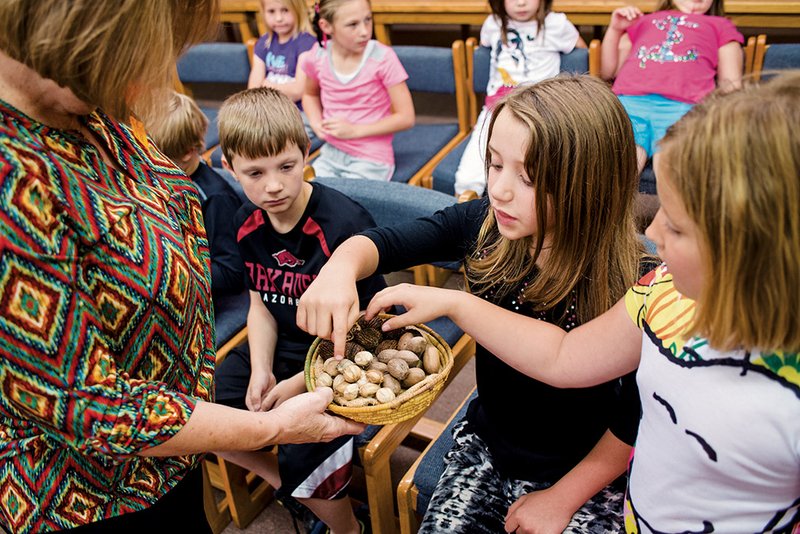One of the thrills of many an American’s childhood is finding an arrowhead or some other small artifact of the Native Americans who lived on this land long before it was called Arkansas and the United States.
On May 8, archaeologist Mary Beth Trubitt shared new information about the Caddo people, who lived along the Ouachita and Saline rivers for as long as 8,000 years, to 50 curious second-graders at Magnet Cove Elementary School.
Trubitt, with the Arkansas Archeological Survey, read to the 8-year-olds from a new book, What’s For Supper? National American Foods in the Ouachita Mountains, by the Ouachita Chapter of the Arkansas Archeological Society. The book is based on Trubitt’s years of research.
Magnet Cove second-grade teacher Terri Hamby said her students are interested in the earliest of Americans who lived in the region.
“These kids are always finding arrowheads and and bringing them in to show to their classmates,” she said. “We studied Indians around Thanksgiving, but the kids are really interested in those that lived right here so long ago.”
The book Trubitt was using was created specifically for second-graders in the area.
“We printed 200 copies with a grant for Arkansas Heritage Month,” Trubitt said. “We are making the rounds presenting the books to second-grade classrooms and elementary school libraries in Garland, Hot Spring, Montgomery, Pike and Polk counties.”
The presentations started with a reading May 6 at the Garland County Library in Hot Springs. A reading was held at Pine Mountain Elementary School the same day. Members of the Ouachita Chapter of the Arkansas Archeological Society will visit 10 schools, including Jessieville and Bismarck elementary schools.
In keeping with this year’s heritage month theme of celebrating the flavors of Arkansas, the book is about the foods the Caddo people hunted, gathered and farmed, based on archeological excavations at Caddo Indian sites in the Ouachita National Forest.
“You can find tools and pottery, and they will tell you many things about how a people lived long ago,” said Trubitt, who is based in Arkadelphia, where she also teaches at Henderson State University. “But to find out what they were eating really gives me a pretty detailed picture of how life was for these people hundreds and even thousands of years ago.”
What’s for Supper? is the story of Kallie, pictured in the book as a red-haired student at Pine Mountain Elementary School. She finds a broken spear point and takes it to an archaeologist and is invited to join in a research dig of a Caddo site in the region.
While she is there, researchers find the site’s garbage dump. Kallie wonders why the researchers get so excited over some very old garbage.
The archaeologist explains that garbage left at settlements includes artifacts of everyday life that can be of great value in telling researchers today how people sustained themselves centuries ago.
“It’s amazing what you can learn,” Trubitt said. “We found nut shells, charred plants, deer bones and mussel shells.”
The big find at the site was burned food found in pots used for cooking. Trubitt said uncooked food would rot and return to the soil in a short while.
“But charred plant remains are preserved for hundreds of years,” she said. “The remains are sent to a botanist, where the plant remains are identified.”
The book covers what the researchers found at two sites in Hot Spring and Montgomery counties.
“The Caddo gathered a lot of nuts — hickory nuts, pecans and walnuts,” Trubitt said. “They also grew a plant called goosefoot, using both the greens and seeds, which were ground into a flour using an ancient food processor — a stone grinder.”
Growing plants for food was a big event for the Caddo people. Starting about 3,000 years ago, the native Arkansans started making small gardens. Trubitt said this was a big event in world history.
“This area of Arkansas is one of only six or eight places in the world where agriculture was invented independently from any other influences,” she said. “Just the process of planting and tending these crops improved them, with larger seeds and bigger yields.”
The discovery of a 600-year-old hearth near Mount Ida has enabled researchers to see many of the foods used during the period. One oddity is that while the Caddo raised gourds and squashes, they ate the seeds and used the outer shells as containers but might not have eaten the flesh of the plants.
The next big advance was the introduction from Mexico of corn, both into the region and the Caddo diet. Archaeologists have said the switch to corn moved many of the people all over the region more into farming and doing less food gathering.
During Trubitt’s talk and reading from the book, students told their stories of finding arrowheads and other artifacts.
“The children were very interested in what we were showing them,” said Janice Fisher of Hot Springs Village, president of the Ouachita Chapter of the Arkansas Archeological Society. “It is incredible to think that these children find things like arrowheads and other stone tools in their yards at home.”
Many of the students told Trubitt about the treasures they have found in their yards or nearby. The education program designed to go with the book teaches the students much more than about the foods of Native Americans.
“The students are getting so much out of the reading,” said Shona Wiley, Magnet Cover’s other second-grade teacher. “It not only gives them the history of these people who lived centuries ago in their own backyard, but expands their vocabulary.
“They are learning words like archaeology, excavatable, artifact, botanist and microscopes,” he said.
Along with the children’s book based on the archeological research, another book, co-written by Trubitt, has been published.
Caddo Connections: Cultural Interactions Within and Beyond the Caddo World was recently published by Rowan & Littlefield. It was written for adult readers.
Staff writer Wayne Bryan can be reached at (501) 244-4460 or at wbryan@arkansasonline.com.
